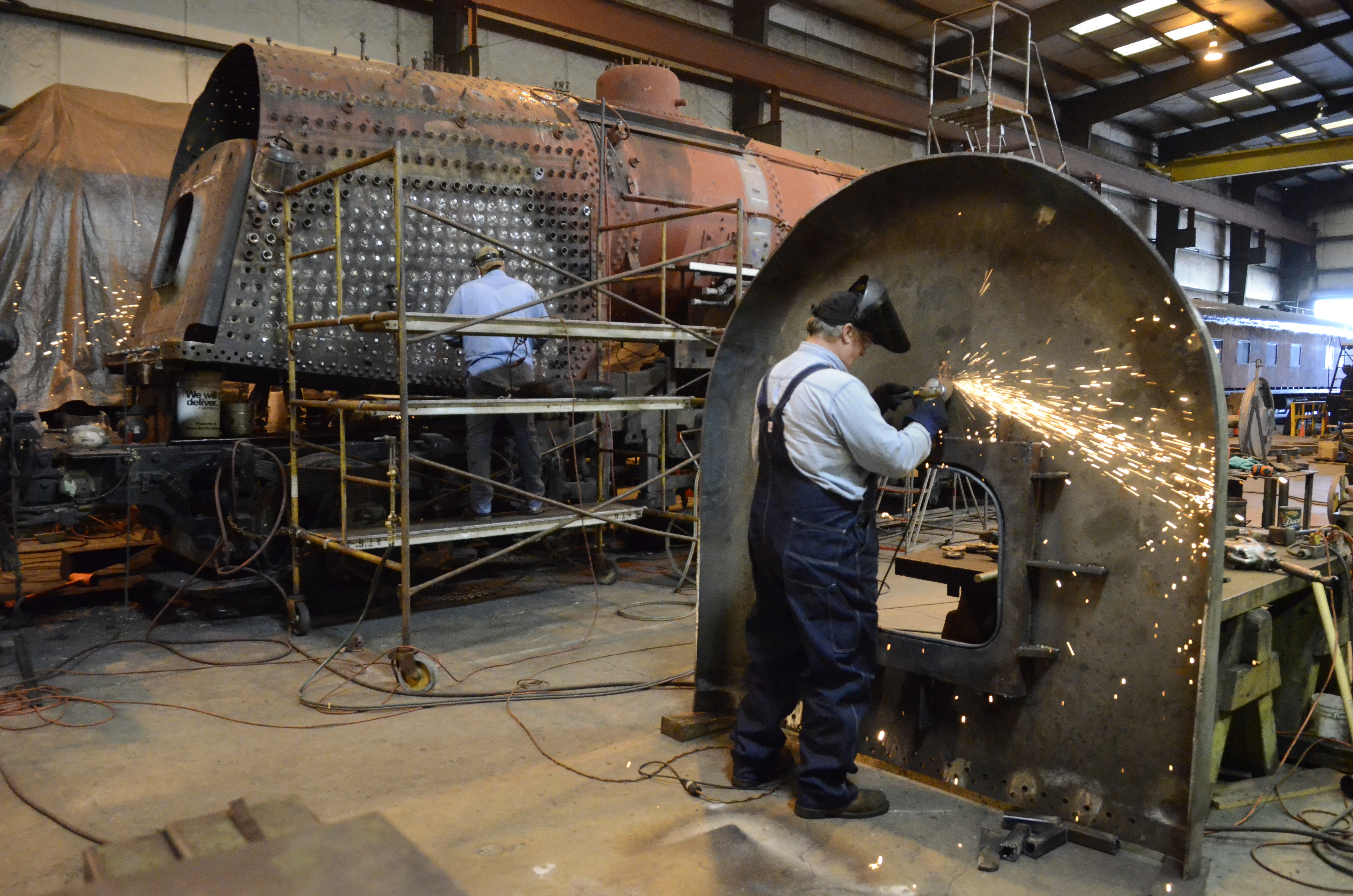Stripped to bare metal, welders' torches in East Chattanooga are burning 101 years of wear off the Southern Railway 4501, the Tennessee Valley Railroad's most famous locomotive.
The steam engine, built in 1911 by Baldwin Locomotive Works, sits on jacks in a shop at the museum's North Chamberlain Avenue location. Sparks fly from both sides of the machine's barreled chest.
Museum staff and Norfolk Southern employees are working on more than a half-million dollar project to restore the engine, rebuilding its boiler, fitting its steel tires and replacing 1,300 bolts on its fire box. The groups are planning to return the well-known 4501 to the rails after more than a decade of retirement.
"It's the most famous," TVRM's Steve Freer said of the coal-fired engine. "A lot of people remember the big green engine."
The railroad museum's equipment, namely its working steam engines, has appeared in more than a dozen films and music videos. The 4501 appeared in movies from the 1971 "Fools' Parade" with Jimmy Stewart to 2011's "Water for Elephants," and for almost two decades it ran steam excursions painted to match the engine displayed in the Smithsonian in Washington, D.C.
"It was our flagship. It's been the symbol of our museum," said Grady Ragan, 77, one of the museum's earliest members. "It ran excursions all over the eastern United States for years and years."
Ragan was part of the group of Chattanooga rail enthusiasts who saved the 4501 from a scrap yard fate in the early 1960s.
The engine, which Southern Railway retired from freight service after the introduction of diesel engines, ran on a Kentucky and Tennessee Railway coal line from 1948 to 1964. Ragan and other TVRM members drove to Stearns, Ky., to buy the engine, and Paul Merriman, first president of the Tennessee Valley Railroad Museum, cut a personal $5,000 check for the 4501.
"We ran it down under its own power," Ragan said.
The group negotiated with Southern to take a passenger train full of the railroad's shippers on an excursion from Kentucky to Chattanooga.
As the steam engine chugged south, people lined the rails for a sight most of them hadn't seen in more than a decade.
"We'd come to most of the towns, Spring City or Dayton, along the way," Ragan said. "There would be hundreds and hundreds of people."
The engine's first overhaul took place on two rails in an uncovered yard, Ragan recalls. Volunteers brought their own tools to work in the heat.
"We never dreamed we'd do stuff like this," Ragan said, looking around at large pieces of industrial equipment in a covered rail shop large enough to work on at least four pieces of full-scale equipment at once. "It's unbelievable what we can do now compared to what we could do back then."
Between 1966 and 1994, the 4501 pulled passenger trains on excursions throughout the Eastern United States.
Ragan and others remained committed to preserving historic rail equipment, making Chattanooga one of the nation's hot spots for steam. Freer said none of the other states near Tennessee has any working steam engines, though Tennessee has five - two in Dollywood, two in Knoxville and one in Chattanooga.
The 4501 will give the railroad museum a second working steam engine, and within five years, Freer said the museum might have three in service at the same time.
Federal regulations only allow steam engines to run for 1,472 days on a boiler, Freer said.
After museum staff fired up the boiler in the 4501 for its final allotted day in the late 1990s, Freer said he never thought he'd see the engine run again. Then in 2010, Norfolk Southern launched its 21st Century Steam excursion program, reaching out to the museum to help in a joint restoration of the 4501.
The new excursion program is designed to bring attention to the railroad industry, said Norfolk Southern spokesman Robin Chapman.
"It's pride in our heritage, for one thing," Chapman said. "But also we want to emphasize that the railroad industry is alive and well. There's a perception out there that the railroads are antiquated and that its days are passed, but that is not the case at all in terms of freight railroads."
Chapman declined to say how much funding the railroad is committing to the project, but Freer estimates the restoration will cost the entities more than the estimated $635,000 the museum spent restoring a smaller engine, the 630.
The overhaul is the "most extensive since it was in operation for Southern Railway," Freer said. "This is just about replacing every nut and bolt on it."
Though the 4501 spent decades as the green engine, Freer said the museum plans to return it to its original black.


